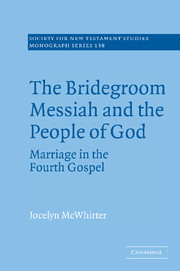Book contents
- Frontmatter
- Contents
- Acknowledgments
- List of abbreviations
- 1 Allusions to biblical texts about marriage
- 2 Echoes of Scripture, representative figures, and messianic exegesis
- 3 The revelation of the bridegroom-Messiah: allusions to Jeremiah 33:10–11 and Genesis 29:1–20
- 4 The glorification of the bridegroom-Messiah: allusions to Song 1:12 and Song 3:1–4
- 5 The bridegroom-Messiah of Psalm 45 in the Song of Songs, Jeremiah 33:10–11, and Genesis 29:1–20
- 6 Hearing the echoes
- 7 Conclusion
- Bibliography
- Scripture index
- Index of ancient commentators
- Index of modern commentators
4 - The glorification of the bridegroom-Messiah: allusions to Song 1:12 and Song 3:1–4
Published online by Cambridge University Press: 22 September 2009
- Frontmatter
- Contents
- Acknowledgments
- List of abbreviations
- 1 Allusions to biblical texts about marriage
- 2 Echoes of Scripture, representative figures, and messianic exegesis
- 3 The revelation of the bridegroom-Messiah: allusions to Jeremiah 33:10–11 and Genesis 29:1–20
- 4 The glorification of the bridegroom-Messiah: allusions to Song 1:12 and Song 3:1–4
- 5 The bridegroom-Messiah of Psalm 45 in the Song of Songs, Jeremiah 33:10–11, and Genesis 29:1–20
- 6 Hearing the echoes
- 7 Conclusion
- Bibliography
- Scripture index
- Index of ancient commentators
- Index of modern commentators
Summary
John 2:1–4:42 introduces Jesus as the bridegroom-Messiah. At Cana in Galilee (2:1–11), he provides abundant wine for a wedding feast, assuming the role of the bridegroom and fulfilling messianic prophecy. At Aenon in Judea (3:22–30), John the Baptist hints that Jesus is the bridegroom foretold by Jeremiah. At Sychar in Samaria (4:4–42), Jesus imitates Jacob at the well and establishes a family of faith. As Jesus reveals his messianic identity, he gains more and more followers. His disciples believe in him (2:11), people flock to be baptized by him (3:23, 30), and the citizens of Sychar declare that he is the Savior of the world (4:42). In terms of John 1:11–13, many receive him, believe in his name, and become God's children.
John 4:43–10:42 continues with the program outlined in John 1:11–13 and initiated in John 1:19–4:42. After Jesus leaves Samaria, however, he faces more rejection than reception. A few come to believe, such as the royal official (4:53) and the man born blind (9:35–38). Most, however, do not accept Jesus. They argue with him about his identity and his mission (5:1–47; 6:1–71; 7:1–52; 8:12–59; 9:13–41; 10:22–39) and they look for an opportunity to do away with him (7:1, 44; 8:20, 59; 10:31, 39). He comes to his own, and his own do not receive him.
In John 11–12, a transition occurs. With the raising of Lazarus, Jesus' own death and resurrection come to the fore.
- Type
- Chapter
- Information
- The Bridegroom Messiah and the People of GodMarriage in the Fourth Gospel, pp. 79 - 105Publisher: Cambridge University PressPrint publication year: 2006



